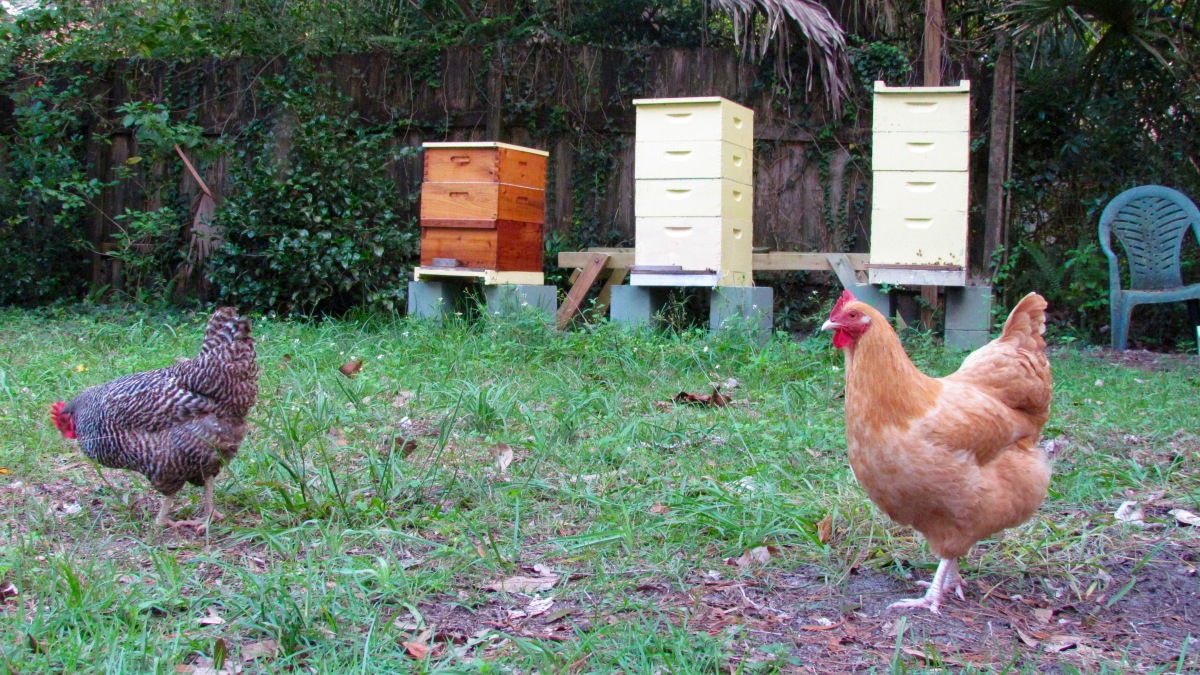By Emily Mavrakis
On a cool October evening, Janice Garry heads into the backyard of her Gainesville home to check on her pets, of which she has more than 250,000.
She has three beehives that stand about five feet tall. The two larger ones each contain about 70,000 to 100,000 bees, while inside her slightly smaller hive there are about 30,000 to 50,000 of the threatened specimens.
Sprawled out on the back porch is her Australian Shepherd, Blue, named so for his bright eyes, while three hens: Emma, Hazel and Little Peep, forage in the grass for bugs.
“One of the great things about the chickens is that they eat things that would otherwise harm the bees,” Garry said.
As president of the Gainesville Area Bee Club for the past four years, Garry has witnessed many trends in her hobby of beekeeping. She also recently heard the news that the United States Fish and Wildlife Service has placed seven yellow-faced bee species native to Hawaii on the endangered species list, a first in U.S. history.
“I hadn’t known they’d been put on the endangered species list until getting all these emails, questions from students at UF and I went, ‘What? What’s this?’ ” the UF medical malpractice claims examiner said.
Her backyard bee oasis may hold answers on how to prevent more species from finding their way onto the endangered species list as well.
Species in danger
U.S. Fish and Wildlife noted habitat loss, predation and competition from invasive species and human activity as some of the factors that contributed to declining yellow-faced bee numbers.
“People have been finding that native bees don’t exist in numbers or ranges that they did 50 years or 100 years ago,” said Susan Harris, a member of the Gainesville Area Bee Club and a UF Master Beekeeper.
Harris said that even though U.S. Fish and Wildlife granted endangered status to seven Hawaii-native species in the Hylaeus genus, other bees across the U.S. face an uncertain future.
“Honeybees particularly wouldn’t be called endangered, but actually they are in danger,” the retired nurse said.
One of the ways bees are accidentally harmed is through the use of chemicals.
Neonicotinoids, a family of insecticides used on crops, may have adverse health effects on bees’ central nervous systems, according to Environmental Protection Agency research. The chemicals, which are already banned in several European Union member states, are currently under review by the EPA.
“The reason [farmers] use neonicotinoids growing plants is so that other pests don’t eat the plant before it’s in good shape, so it can be sold to the homeowner,” Harris said.
These sub-lethal impacts are sometimes more harmful to the species as a whole than some chemicals that would cause the bees to die right away, Harris said.
“Wax [created and stored by bees in a hive] is a hydrocarbon, which then holds chemicals, so [the chemicals] can be there right where the new bees are developing, and they might pass on something to those new bees,” she said.

Bees are often used for commercial crop pollination and are sometimes transported across the country to pollinate different areas, but this, too, may be putting their lives at risk.
“It’s very similar to when you and I go on a plane and we fly across the country, and we get exposed to every virus and bacteria between here and wherever we’re flying,” Garry said. “And honeybees are the same way.”
In South Carolina, colonies have been completely wiped out as a result of spraying to combat the zika virus. Garry, concerned that her bees may face a similar fate, decided to contact the city of Gainesville.
Mosquito control trucks in Gainesville spray neighborhoods for virus prevention, but Garry said she was able to contact the city and put her residence on the ‘no spray list’ so her bees are not affected. The spray is dispersed at nighttime and dissipates by morning so that no people or animals outside are impacted.
“I have been in my home when they’ve gone by and you can here it spraying,” Garry said. “And then you can hear it click off when they go past my home, and then click back on.”
Urban dwellers
Garry’s home, located in the heart of Gainesville and just a few miles from the main campus of the University of Florida, is perhaps not the place everyone would think of for keeping bees, but on the contrary, Garry’s bees are some of the most successful of the Bee Club members.
“Actually, being in the city is one of the best places you can be to have bees because there’s always something blooming,” she said. “If you’re out in the country, ironically, a lot of times during the season there will be nothing blooming, and so people have to feed them sugar water.”
A 2012 Florida law passed under Governor Rick Scott made it legal for residents to keep bees in urban areas so long as they are registered with the state and regularly inspected.
The maximum amount of hives one is allowed to have in a city is three, with two additional temporary hives during peak months, Garry said.
The number of registered Florida beekeepers is about 4,000 as of 2016, according to the Florida Department of Agriculture and Consumer Services.
Just a few years ago, that number was less than 1,000, Harris said.
Garry is hopeful that recent news stories will increase the number of beekeepers, especially those living in cities.
“Interestingly, there are now more backyard beekeepers than commercial beekeepers,” Garry said. “It used to be the other way around.”
She said anyone interested in starting their own hives should prepare for failure and give themselves at least six month of research and preparation before getting started. State organizations and other clubs provide a variety of ways prospective beekeepers can learn more about the process.
“It’s not like getting a kitten. It’s way more complicated, Garry said. “But on the other hand, you study, and if you’re fortunate, you have a very dynamic club like ours where there are people who are there to assist you.”
Just as each individual worker bee helps one another to create a functional hive, Garry said, people can work together and combine their efforts to help save bees.
“If people know more about what’s happening and then have some tools to help habitat [sic] in your own yard, the individual work each person in their own little yard or their own little way… that all does help,” Harris said.

One thought on “Keeping bees in cities can benefit threatened populations”